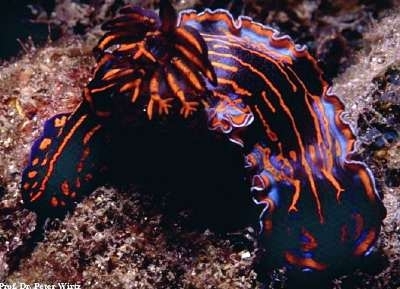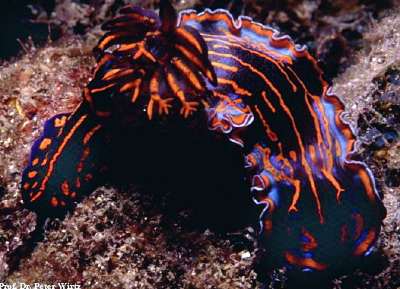
Hypselodoris picta verdensis
Ortea, Valdés & García-Gómez, 1996
Order: NUDIBRANCHIA
Suborder: DORIDINA
Superfamily: EUDORIDOIDEA
Family: Chromodorididae
DISTRIBUTION
Considered endemic to Cape Verde Islands, São Tomé and southern Angola (Ortea et al,1996).
PHOTO
Bom Bom Island, Principe, São Tomé and Principe, Gulf of Guinea. March 2004. on vertical rock faces in a depth range of 1 - 10 m. Approx 7 cm long alive. Photo: Peter Wirtz.
Ortea, Valdés and García-Gómez, (1996) designated this colour form as a subspecies Hypselodoris picta verdensis. It is characterised by its dark blue background colour, longitudinal thin orange lines, orange submarginal border and orange lined gills. There are also lighter blue patches along the inside of the submarginal orange mantle border. It is difficult to separate this colour form from Hypselodoris tema Edmunds (1981), which Ortea et al (1996) consider a subspecies of Hypselodoris picta. In fact Edmund's Fig 12 D of a 90 mm H. tema from Ghana is almost identical. If we look at the photos of H. picta tema on the Forum we can see the variability Edmunds described from Ghana is identical to the variability in specimens from Senegal. I am not sure what to say about the variation from Equatorial Guinea [message #8158] but it looks identical to another animal from Ghana, pictured in Ortea et al (1996: Fig 10F).
Ortea, Valdes & Garcia-Gomez (1996) named this colour form Hypselodoris picta verdensis subespecie nueva but they have not followed normal accepted nomenclatural practice so I doubt if the name is valid. To validly name a subspecies they should have followed the same rules as apply to naming a species, such as characters that differentiate the species from related species and allocating a type specimen. It is important to designate type specimens so that if later there are problems in identifying the species (or subspecies) there is a reference specimen we can go back to. This is specially important in groups, like the chromodorids, where we have so many problems in separating similarly coloured species - like the blue ones in the Mediterranean. As I have discussed above, this colour form seems to merge into Hypselodoris tema Edmunds (1981) which Ortea et al also consider a subspecies of H. picta.
-
Edmunds, M. (1981) Opisthobranchiate Mollusca from Ghana: Chromodorididae. Zoological Journal of the Linnean Society, 72(2): 175-201.
-
Ortea, J., Valdés, A. & and García-Gómez, J.C. (1996) Revisión de las especies atlánticas de la familia Chromodorididae (Mollusca: Nudibranchia) de grupo cromático azul. [Review of the Atlantic species of the family Chromodorididae (Mollusca: Nudibranchia) of the blue chromatic group.] Avicennia, 1996, Suppl. 1: 1-165.
Rudman, W.B., 2006 (June 8) Hypselodoris picta verdensis Ortea, Valdés & García-Gómez, 1996. [In] Sea Slug Forum. Australian Museum, Sydney. Available from http://www.seaslugforum.net/find/hypsverd
Related messages
Hypselodoris picta verdensis from Príncipe Island
June 10, 2006
From: Peter Wirtz

During an expedition to the island of Príncipe (Gulf of Guinea, eastern central Atlantic) in February and March 2004, marine invertebrates were photographed and collected in a depth range of 0 - 60 m. One of the nudibranchs encountered, not previously recorded for the area was Hypselodoris picta verdensis Ortea, Valdés and García-Gómez, 1996
Three different individuals of about 7 cm length were encountered during three different dives in the area of Bom Bom Island, during daytime, on vertical rock faces in a depth range of 1 - 10 m. Hypselodoris picta is a variable species living on both sides of the Atlantic. The subspecies H. picta verdensis is known from the Cape Verde Islands, São Tomé and southern Angola (Ortea et al. 1996).
-
Wirtz, P. 2004. A note on nudibranchs (Mollusca Opisthobranchia) from Príncipe Island (eastern central Atlantic). Arquipélago. Life and Marine Sciences, 21A: 81-82.
Peter Wirtz
biomar@dragoeiro.uma.pt
Wirtz, P., 2006 (Jun 10) Hypselodoris picta verdensis from Príncipe Island. [Message in] Sea Slug Forum. Australian Museum, Sydney. Available from http://www.seaslugforum.net/find/15607Dear Peter,
Thanks very much for this photo. It looks almost identical, if slightly darker, to Malcolm Edmunds' (1981) description of his Hypselodoris tema, a species which Ortea et al (1996) also considered a subspecies of Hypselodoris picta. In fact Edmund's photo (Fig 12 D) of a 90 mm animal from Ghana is very similar. Cape Verde Islands aren't that far from Ghana, so it seems strange to me that two 'subspecies' are necessary. If we look at the photos of H. picta tema on the Forum we can see the variability Edmunds described from Ghana is identical to the variability in specimens from Senegal. I am not sure what to say about the variant from Equatorial Guinea [message #8158] but it looks identical to another animal from Ghana, pictured in Ortea et al (1996: Fig 10F).
-
Edmunds, M. (1981) Opisthobranchiate Mollusca from Ghana: Chromodorididae. Zoological Journal of the Linnean Society, 72(2): 175-201.
-
Ortea, J., Valdés, A. & and García-Gómez, J.C. (1996) Revisión de las especies atlánticas de la familia Chromodorididae (Mollusca: Nudibranchia) de grupo cromático azul. [Review of the Atlantic species of the family Chromodorididae (Mollusca: Nudibranchia) of the blue chromatic group.] Avicennia, 1996, Suppl. 1: 1-165.
Best wishes,
Bill Rudman
